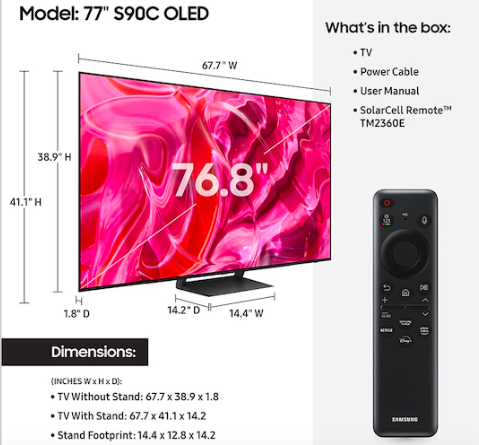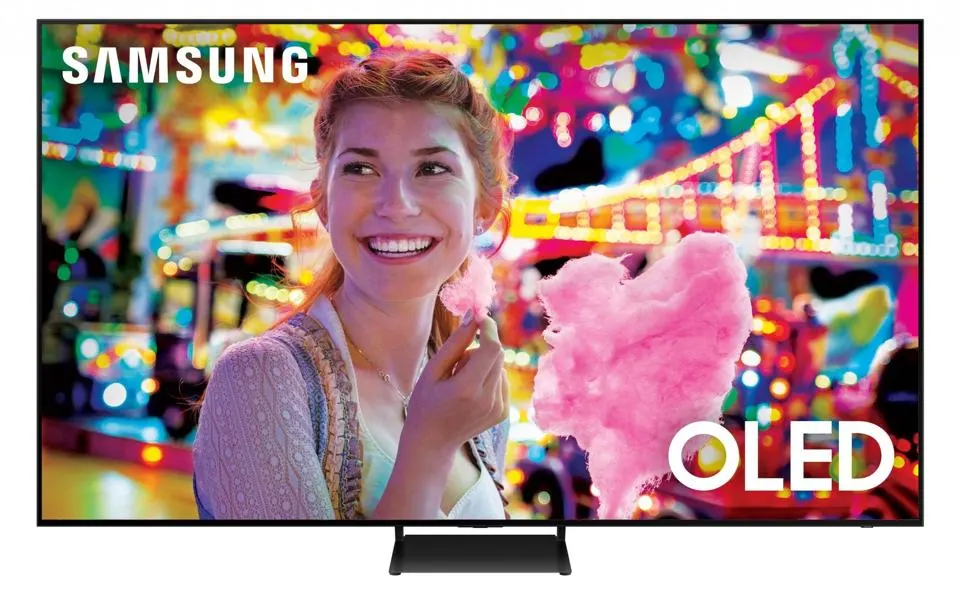Samsung, the world’s biggest TV manufacturer, has announced plans to launch its largest and most impressive OLED TV to date. However, in a surprising twist, the company will not be producing the panels itself.
Instead, it will be sourcing them from its long-standing rival, LG Display. This unexpected move signifies a significant shift in Samsung’s strategy and highlights the increasing competition in the OLED TV market.
Unveiling the 83S90C: Samsung’s Massive 83-Inch TV
The game-changing TV, dubbed the 83S90C, boasts an enormous 83-inch screen, surpassing the previous 77-inch model that marked the upper limit of Samsung’s S90C range.
While the use of an LG Display panel is a huge departure from Samsung’s usual approach, the company has been tight-lipped about this unexpected collaboration, choosing not to emphasize this previously unthinkable fact. The 83S90C is set to go on sale in the US this week with a recommended price of $5,400.
The shift in panel sourcing means that the 83S90C will feature WOLED/WRGB technology instead of Samsung Display’s Quantum Dot OLED technology used in its other OLED TVs.
The WOLED approach incorporates a white element to enhance brightness, while Samsung has been critical of this technology due to concerns about color tones in high-brightness areas, the potential for permanent image retention, and the fact that its what LG uses.

Nonetheless, Samsung has now chosen to embrace WOLED technology, indicating the advancements made in performance and long-term reliability in recent years.
Shifting Landscapes in OLED TVs
Samsung’s decision to add a WOLED TV to its QD OLED range raises questions about its future TV offerings. Will QD OLED remain a premium technology, with WOLED used for more affordable models? Will Samsung mix QD OLED and WOLED within its OLED series based on screen size?
Additionally, this move prompts speculation about the future of LED and Mini LED TV technologies, which Samsung has vigorously promoted.
Is Samsung shifting its focus toward self-emissive OLED technology in its mid-range and high-end segments? These questions may find answers when Samsung unveils its 2024 TV range, possibly at the next CES in Las Vegas.
The deal between Samsung and LG Display is a surprising development in their long-standing rivalry. Both companies have competed head-to-head in the TV market, often unveiling products with similar specifications and sizes at trade shows.
Reuters reports that Samsung has signed an agreement to purchase LG Display’s WOLED TV panels. LG Display plans to supply two million panels next year, followed by three million and five million units in 2025 and 2026, respectively.
Samsung’s move to embrace OLED panels from its rival could help the company gain ground in the OLED TV market. With a 6.1% market share, Samsung currently lags behind LG Electronics with 54.6% and Sony with 26.1%, according to market research firm Omdia.
The agreement with LG Display positions Samsung to potentially surpass Sony as the second-largest supplier of OLED TVs globally.
For LG Display, the deal signifies a significant boost. Shipments of two million OLED panels to Samsung next year alone could be worth at least $1.5 billion and account for 20%-30% of LG Display’s total manufacturing capacity for large-size OLED panels.
This partnership could help LG Display recover from four consecutive quarters of losses and maximize its production capacity.
Samsung’s Strategic Sourcing
Samsung’s decision to source OLED panels from LG Display may be driven by volume and screen size availability concerns. Vincent Teoh of HDTVTest commented saying:
“QD-OLED panel production from Samsung Display is still limited in quantity at the moment, and the motherglass has to be cut to cater for both monitors (e.g. 34-inch 240Hz QD-OLED gaming monitors which are greater in demand) and TVs (e.g. 55-inch QD-OLED TV).”
LG Display’s WOLED panels offer a wider range of sizes, including larger options up to 83 and even 97 inches, as well as smaller sizes like 42 and 48 inches.
As the TV market evolves, Samsung’s surprising collaboration with LG Display reflects its efforts to diversify its supply chain and strengthen its premium lineup. The market is projected to grow to $12.9 billion by 2027, according to Omdia, and Samsung wants to capture as much of that value as it can.
Samsung’s decision to source OLED panels from its rival LG Display marks a significant shift in strategy. This unexpected collaboration allows Samsung to offer larger OLED TVs and expand its presence in the OLED market but it also supports its rival at the same time.
The partnership also benefits LG Display, providing a major boost to its business and helping it return to profitability.
As the TV industry continues to evolve, the answers to questions about Samsung’s future TV offerings and its approach to different display technologies will likely come to light when the company unveils its 2024 TV range.
Related Articles
- How to Buy Samsung Stock in 2023
- Amazon’s Prime Day is a Roaring Success as Average Order Size Jumps by 8%
- Webb Telescope News: Captivating Anniversary Image Release
What's the Best Crypto to Buy Now?
- B2C Listed the Top Rated Cryptocurrencies for 2023
- Get Early Access to Presales & Private Sales
- KYC Verified & Audited, Public Teams
- Most Voted for Tokens on CoinSniper
- Upcoming Listings on Exchanges, NFT Drops
